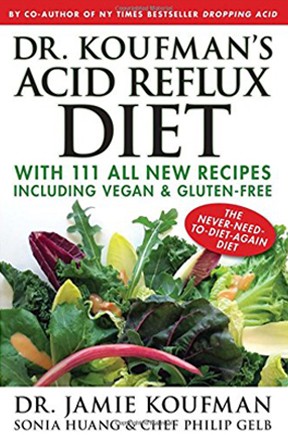Acid Reflux? pH (Acidity) Measurements of Fruits and Vegetables
At-A-Glance
- This post provides a relatively comprehensive list of the pH (acidity) of most common fruits and vegetables in my area, North Carolina … it is in response to requests by followers with acid reflux, including heartburn, GERD, LPR, silent reflux, and respiratory reflux.
- If you are just starting out on a “reflux detox” program, you shouldn’t consume anything below pH 5, and all refluxers should generally avoid citrus and soft drinks. After your reflux is under control, I recommend that you don’t load your diet with items below pH 4; stay judicious and learn to do some pH-balancing.
Why Is a Low-Acid, Alkaline Diet Important for People with Acid Reflux
Being on a low-acid, alkaline diet is not to neutralize acid in your stomach. There is a lot of misinformation about this on the internet; there are no tricks that alter the acidic pH of the stomach completely. It can’t be done; it would have no benefits; and it has nothing to do with acid reflux treatment. Also, the pH inside us, of our blood, is always maintained at 7.4 regardless of what you eat or drink.
The purpose of a low-acid diet for reflux is to heal inflammation in your esophagus, throat, and airway; in fact, to eradicate tissue-bound pepsin. Pepsin, the main enzyme of the stomach, causes all the trouble, but it is activated by acid … even drinking a Coke or eating a grapefruit will turn it on.
Dr. Koufman’s (my) reflux diet has three phases: (1) Reflux detox, (2) Transition, and (3) Maintenance. The detox program should be strictly alkaline. After detox, things can be loosened up a little. I recommend that you read my blogs on pepsin, What Is Pepsin? and How to Get Rid of Pepsin, as well as the Silent Reflux blog, and my book Dr. Koufman’s Reflux Diet, which discusses all three stages of my reflux program.
At the beginning of the reflux detox, strictly follow the rule to consume nothing below pH 5; this is well covered in Dropping Acid: The Reflux Diet Cookbook & Cure. You can use pH Paper to test items. FYI: You really don’t need a pH meter and it is not that easy to use properly, e.g., calibration, cleaning, etc. between test items.
A Reminder About pH as a Measure of Acidity
The pH scale, used to measure acidity, is somewhat counterintuitive. As the pH value increases, the acidity decreases: pH 7 is neutral; pH 1 is very acidic, and caustics like bleach have pH values from pH 8-14. It is also a logarithmic scale, so pH 4 is ten times more acidic than pH 5; and pH 4.8 is twice as acidic as 5.0; this explains why diluting acidic beverages doesn’t make them non-acidic. The normal range for stomach acid is pH 1-4.
Why Is There Variation in the pH of Some Items?
People ask me why there is variation in the measured pH values of foods, especially fruits and vegetables in different articles and books. If you read my post on Onions, you will see that sweet onions are less acidic than others because they grow in less acidic soil. So, where a fruit or vegetable comes from, where it is grown, may influence its pH due to the acid level in the soil at the source.
pH of Common Fruits and Vegetables (High to Low)
7.3 Olives (Canned Black, Best Brand)
7.2 Almond milk
7.2 Coconut milk
7.0 Black beans (Goya)
7.0 Avocado
6.9 Corn (Cob)
6.8 Cauliflower
6.8 Broccoli
6.6 Spinach
6.6 Garlic
6.6 Corn (Whole kernel, Del Monte)
6.5 Zucchini
6.5 Watermelon
6.5 Bell pepper (Yellow)
6.5 Beet
6.4 String beans
6.4 Ginger root
6.4 Garlic
6.4 Basil
6.3 Radish
6.3 Bell pepper (Red)
6.3 Bell pepper (Orange)
6.2 Mushroom (Portobello)
6.2 Cilantro
6.2 Arugula
6.1 Parsley
6.1 Endive
6.1 Cucumber
6.1 Carrot
6.0 Kale
6.0 Cantaloupe
6.0 Bok choy
6.0 Bell pepper (Green)
6.0 Aloe vera (Leaf)
5.8 Peas (Canned, small, Le Sueur)
5.8 Fennel
5.8 Celery
5.7 Leek
5.7 Banana
5.6 Potato (Russet, cooked)
5.6 Lentil (Soup, Progresso)
5.6 Collard greens
5.5 Radicchio
5.5 Lettuce (Iceberg)
5.4 Coffee (black)
5.3 Honeydew melon
5.3 Dates (Medjool)
5.2 Green beans (Green Giant)
5.2 Eggplant
5.2 Apple (Red, Fuji)
5.0 Apple (Jazz)
5.0 Onion (sweet Vidalia)
4.8 Tomato (Globe)
4.6 Tomato (Heirloom)
4.5 Plum
4.5 Pear
4.5 Nectarine
4.5 Fig
4.4 Peach
4.4 Orange (Naval)
4.3 Date (Medjool
4.3 Orange (Naval)
4.2 V8 (Vegetable juice)
4.2 Apple (Honey Crisp)
4.1 Apple (Gala)
4.1 Tomatoes (Whole peeled, Best Yet)
4.1 Tomato sauce (Ragu, Pizza Quick)
4.1 Tomato sauce (Organic, Del Monte)
4.0 Tomatoes (Diced, San Marzano)
4.0 Tomato sauce (With mushrooms, Prego)
4.0 Tomato paste (Hunt’s)
4.0 Apple (Red Delicious)
3.9 Apple (Golden Delicious)
3.9 Cherries (Frozen, store brand)
3.9 Tomatoes (Whole peeled, San Marzano)
3.9 Tomato sauce (Del Monte)
3.9 Tomato juice (Campbell’s)
3.8 Olive (Green)
3.7 Pickle (Dill, B&G)
3.7 Grape (Green)
3.7 Grape (Red)
3.7 Apple (McIntosh)
3.7 Apple (Granny Smith)
3.5 Strawberry
3.5 Star fruit
3.5 Onion (Red)
3.5 Blackberry
3.5 Apple sauce (Store brand)
3.4 Olive (Calamata)
3.4 Mango (In syrup, Del Monte)
3.4 Mango
3.4 Kiwi
3.4 Grapefruit (Pink)
3.4 Applesauce (Mott’s)
3.3 Raspberry
3.3 Pomegranate
3.3 Pickles (Cornichons)
3.3 Papaya
3.3 Nectarine
3.3 Grapefruit
3.3 Blueberry
3.2 Mandarin oranges (Dole)
3.2 Apple (Macoun)
3.1 Texas Pete
3.1 Pineapple
3.0 Peaches (Frozen, store brand)
3.0 Apple cider vinegar
2.7 Lime
2.7 Lemon
Alphabetical List of the pH of Fruits and Vegetables
Almond milk … 7.2
Aloe vera (Leaf) … 6.0
Apple (Gala) … 4.1
Apple (Golden Delicious) … 3.9
Apple (Granny Smith) … 3.7
Apple (Honey Crisp) … 4.2
Apple (Jazz) … 5.0
Apple (Macoun) … 3.2
Apple (McIntosh) … 3.7
Apple (Red, Delicious) … 4.0
Apple (Red, Fuji) … 5.2
Apple cider vinegar … 3.0
Apple sauce (Mott’s) … 3.4
Apple sauce (Store brand) … 3.5
Arugula … 6.2
Avocado … 7.0
Banana … 5.7
Basil … 6.4
Beet … 6.5
Bell pepper (Green) … 6.0
Bell pepper (Orange) … 6.3
Bell pepper (Red) … 6.3
Bell pepper (Yellow) … 6.5
Black Beans (Canned, Goya) … 6.0
Blackberry … 3.5
Blueberry … 3.3
Bok choy … 6.0
Broccoli … 6.8
Cantaloupe … 6.0
Carrot … 6.1
Cauliflower … 7.1
Celery … 5.8
Cherries (Frozen, store brand) … 3.9
Cilantro … 6.2
Coconut milk ··· 7.2
Coffee (black) … 5.4
Collard greens ··· 5.6
Corn (Canned, Del Monte) … 6.6
Corn (Cob) … 6.9
Cucumber … 6.1
Date (Medjool) … 5.3
Eggplant … 5.2
Endive … 6.1
Fennel … 5.8
Fig … 4.5
Garlic … 6.6
Ginger root … 6.6
Grape (Green) … 3.7
Grape (Red) … 3.7
Grapefruit (Pink) … 3.4
Grapefruit … 3.3
Green beans (Canned, Green Giant) … 5.2
Honeydew melon … 5.3
Kale … 6.0
Kiwi … 3.4
Leek … 5.7
Lemon … 2.Lentil (Soup, Progresso) … 5.6
Lentil (Soup, Progresso) … 5.6
Lettuce (Iceberg) … 5.5
Lime … 2.7
Mandarin oranges (Dole) … 3.2
Mango (In syrup, Del Monte) … 3.4
Mango … 3.7
Mushroom (Portobello) … 6.2
Nectarine … 3.3
Olives (Black, Best Brand) … 7.3
Olives (Calamata) … 3.4
Olives (Green) … 3.8
Onion (Red) … 3.5
Onion (sweet Vidalia) … 5.0
Papaya … 3.3
Parsley … 6.1
Peach (Fresh, ripe) … 4.4
Peaches (Frozen, store brand) … 3.0
Pear … 4.5
Peas (Canned, small, Le Sueur) … 5.8
Pickle (Cornichon) … 3.3
Pickle (Dill, B&G) … 3.7
Pineapple … 3.1
Plum … 4.5
Pomegranate … 3.3
Potato (Russet, cooked) … 5.6
Radicchio … 7.4
Radish … 6.3
Raspberry … 3.3
Spinach … 6.6
Star fruit … 3.5
Strawberry … 3.5
String beans …6.4
Texas Pete … 3.1
Tomato (Globe) … 4.8
Tomato (Heirloom) … 4.6
Tomato juice (Campbell’s) … 3.9
Tomato paste (Hunt’s) … 4.0
Tomato sauce (Del Monte) … 3.9
Tomato sauce (Organic, Del Monte) … 4.1
Tomato sauce (Ragu, Pizza Quick) … 4.1
Tomato sauce (With mushrooms, Prego) … 4.0
Tomatoes (Diced, San Marzano) … 4.0
Tomatoes (Whole peeled, Best Yet) … 4.1
Tomatoes (Whole peeled, San Marzano) … 3.9
V8 (Vegetable juice) … 4.2
Watermelon … 6.5
Zucchini … 6.5









